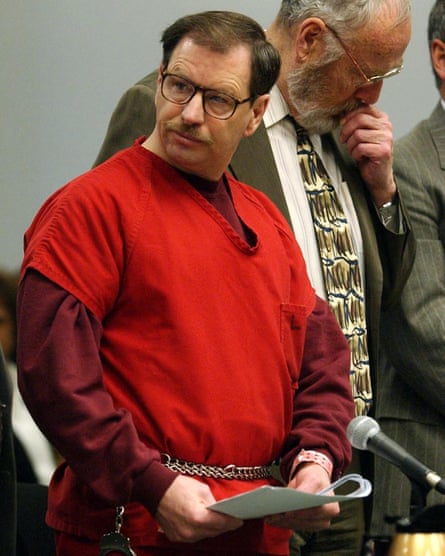When John Joseph DeAngelo was pushed into a courtroom wearing an orange jumpsuit, handcuffed to a wheelchair earlier this year, the former California cop was finally called to account for a murder spree he allegedly began in the 1970s.
A Vietnam veteran, he had apparently already begun to kill by the time he was thrown out of the police force in the late 1970s. But for decades, justice did not catch up with DeAngelo, until advances in technology finally did. He is now due to stand trial on 13 counts of murder, after biological data held by a genealogy website led investigators to the door of the man they say is the Golden State Killer.
The 72-year-old was arrested after investigators created a fake profile on a popular genealogy website called GEDmatch and uploaded genetic data from a well-preserved crime scene DNA sample. The website led them to several distant relatives of the suspect.
Retired attorney Barbara Rae-Venter, an expert in genetic genealogy, helped build a family tree and, from genetic data, a profile of a balding, blue-eyed suspect. Her efforts led investigators to DeAngelo, living in retirement in California.
If DeAngelo’s long-awaited appearance in court suggests a reckoning is coming for serial killers, long-term trends indicate that such mass killers and their impact might already be in decline in American society.
Author Peter Vronsky, who has just published a new history of serial killers, said in a Guardian interview last month: “It appears that we’re arresting and apprehending less serial killers, and when we do apprehend them they have a much smaller victim list, per killer. So yes, there seems to be a decline in American serial killing. Either there are less serial killers or we have gotten better at catching them earlier.”
The best database of serial killers was developed by Mike Aamodt, emeritus professor at Radford University in Virginia. He agrees there has been a clear downward trend, but urges caution.
“There’s no question that there has been in a decline since the 80s in the number of identified serial killers,” he said. “I’m careful to say there has been a decline in the number of serial killers we can identify – there could be thousands of serial killers that we don’t know about and for some reason we’re not identifying today as well as we did in the 70s, 80s and 90s. All we know for sure is there has been a decline in the number identified.”

The Radford database, maintained in collaboration with Florida Gulf State University, has identified 5,000 serial killers from 1900 to today.
Taking the definition of serial murder as the unlawful killing of two or more victims by the same offender in separate events, the data shows 1989 was the peak year in the United States with 193 separate serial killers operating.
By the end of the 20th century, that had dropped to 107. In the current decade, an average of 43 serial killers per year have been identified in the US.
Some studies suggest the surge in serial killing was a phenomenon of urban living, the “society of strangers” thesis, where cities provided both anonymity and opportunity as people were brought closer together.
Aamodt said reasons for the apparent decline in serial killing could include advances in forensic technology, tighter use of parole and more widespread caution in the way people live. All factors which suggest victims have become harder to target and criminals easier to catch.
“One of the big reasons for the decline is change in parole,” Aamodt said. “Not quite 20% of our serial killers were people who had killed, gone to prison and had been released and killed again. With the longer prison sentences and the reduction in parole, those folks are not going to be back on the streets to kill again.
“The second factor, people have changed their behaviour. Go back and think about the 1970s, we would hitchhike, we would let kids walk to the store, let ’em go play. If there was a stranded motorist you’d go and help them – we don’t do those things any more. What we call the free-range behaviours are on the decline and it’s more difficult for serial killers to find victims than it has been in the 70s and 80s.”
Forensic skills have improved too and smaller DNA samples can be viable. “There isn’t data to support this, but it may be we are catching people after a single murder, before they commit two or three,” Aamodt said.
The Radford/FGCU data debunks the serial killer stereotype of the intellectual genius always outwitting law enforcement – there is a cluster of killers with average to low intelligence, Aamodt said.
And although the perception is that most serial killers are white men, data for the past three decades shows they have been overtaken by black serial killers – a trend which appears to be partly driven by a higher proportion of so-called “organisational” serial killers who commit murder as part of a gang or criminal operation.
Retired FBI agent and profiler Mary Ellen O’Toole, who worked on some of the most infamous serial killer cases in US history, said another factor was the proliferation of security cameras. “There are so many more cameras out there now that law enforcement is able to go back to look at,” she said. Cellphone location data has also made it easier to reconstruct the movements of suspects.

O’Toole is now director at George Mason University’s forensic science programme, guiding the next generation of experts who increasingly come from fields of chemistry and biology. “They have grown up on shows like CSI and Law and Order and they all want to take part in some aspect of criminal investigation,” she said, preparing for jobs at the cutting edge in disciplines such as forensic toxicology.
During her FBI career, she interviewed the Unabomber and was instrumental in the interviews of Gary Ridgway, the Green River Killer, the most prolific serial killer in US history, based upon confirmed murders.
The case of Ridgway, who kept children’s toys in his car and made sure women saw pictures of his son in his wallet, exemplifies the risk of relying upon gut instinct in judging people, she said.
“The nextdoor neighbour will always say that he was the nicest guy. These people don’t necessarily look scary, they don’t have some kind of mark on them.”
She questions whether anyone can say with certainty that serial killers have become more scarce. “How many serial killers are there out there right now? There’s just no way to know that,” she said.
“Advances in DNA have been really significant – the way they were able to identify the Golden State Killer, it was a very creative way to use the DNA data. That is the gold standard of technology right now.”
After the high-profile breakthrough in the DeAngelo case, the DNA techniques are being utilised in a succession of other cold cases.
“People who upload information [to genealogy websites] are upset about it, but my view, if you can solve more cases, and do it legally, then do it,” O’Toole said.
